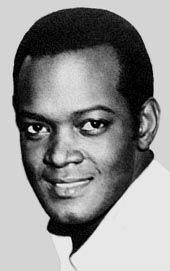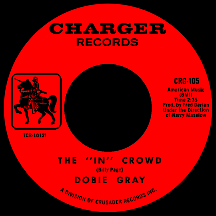DOBIE GRAY
The "In" Crowd
When Billy Page wrote the lyrics to "The 'In' Crowd," it probably wasn't his intention to glorify the social group that claimed 'We breeze up and down the street...we get respect from the people we meet' while shunning the geeks, freaks and misfits...in other words, the rest of us, the 90 percent majority that might not warm up to a song about those nauseatingly cool kids whose '...share is always the biggest amount,' as Page's words suggest. But maybe the "outcasts" secretly cared about social standing; the song was a hit in 1965 for Texas-born singer Dobie Gray, who'd actually come up with the title. Dobie spent the next eight years mostly on the fringe of the record industry, somewhere between the "in" and "out" crowds, before major success was once again his. Then the cycle repeated a few more times as the decades passed.
Little realizing the challenge ahead, Lawrence Darrow Brown left his home in Houston, just east of Brookshire, where he grew up. Just 17 in 1957, he headed to Los Angeles, lived with relatives and finished school while trying to forge a few music biz connections. In 1960 he did an impromptu audition for Specialty's Sonny Bono, who set him up with manager Al Stewart. Brown made his first record, Wayne Shanklin's "I Can Hardly Wait," for a startup label, Stripe (that was only in business a little over a year), under the name Dobie Gray (lifted from Dwayne Hickman's title character on the CBS-TV sitcom The Many Loves of Dobie Gillis). His third release, "Delia" (a variation of "Delia Gone," a minor hit at the time for Pat Boone), probably got the most airplay of the six singles he did for Stripe in '60 and '61.
Fred Darian started his CorDak label in the summer of '62 and coaxed Dobie onto the roster. Johnny Cole, a New York-born singer who'd been involved with Darian's group The Balladeers, penned a simple six-line song of woe ('I got tears, tears, tears in my eyes...and I got pain, pain in my heart...') contained within a smokin' brass arrangement; "Look At Me" was a hit in the L.A. area during the latter months of 1962 and made a short stop on Billboard's lower rungs in January '63. Still, Gray was able to milk this minor breakthrough, in SoCal at least, for the next couple of years. A couple more for CorDak and a remake of Jimmy Durante's trademark tune "Inka Dinka Doo" on JAF placed him back at square one...then he heard a cab driver talking about "...where the in crowd goes" and it got him thinking the phrase might make a good song.
Dobie told Billy Page about his idea and the song was quickly written, and published, under Page's name (and no one else's). Dobie recorded it in late '64 at L.A.'s home of the hits, the Gold Star studio, with uncredited vocal backing by The Extremes (they'd had a single on the bizarro Paro label at the same time Dobie was hollering 'Huh! Huh!' on "Look At Me") and "The 'In' Crowd" on Charger (a twin to Crusader Records) was a hit in the winter months of '65, breaking Gray from coast to coast on radio and TV and further exposing Page's song, which was even bigger come summertime as a jazz instrumental by The Ramsey Lewis Trio, a top ten smash with a like-titled LP that hovered around the million mark in sales. Gray gigged at the Whisky a Go Go at the same time Johnny Rivers recorded his string of "live" hits there. Dobie and the Extremes (still uncredited!) cranked out a follow-up, "See You at the 'Go-Go'," as a tribute to (or commercial for?) the trendy Sunset Strip dance club.

The next three singles on Charger stiffed...or did they? Gray lip-synced his final effort for the label, "Out on the Floor," in Out of Sight, a teen/spy spoof directed by Lennie Weinrib (with a largely unknown cast) that hit theaters in the spring of '66 (the song's lyrics even contain the line 'Babe it's out of sight...'); the record became a hot dance floor favorite in England about a decade later, popularized by deejays in British clubs like the Wigan Casino near Manchester. To a certain segment of music fans, it's Dobie Gray's all-time greatest hit. In 1967 he signed with Capitol and worked closely with producer Al DeLory and arranger Leon Russell on a cover of the Phil Spector-Jeff Barry-Ellie Greenwich fantasia "River Deep - Mountain High," already definitively committed to vinyl by Ike and Tina Turner via Spector, though it thrived in the U.K., struggled in the U.S. and achieved legendary status only after the passage of many years. Dobie's version tanked. He'd had his first big hit and a classic follow-up...he just didn't realize it yet. And another killer hit was yet to come.
A big change took place in Dobie's career after he took some acting classes and landed roles in ensemble theater group presentations of A Raisin in the Sun and other plays. This led to a starring role in the Los Angeles production of rock's hottest musical, Hair, which had a run at the Aquarius Theater on Sunset Boulevard from 1968 to 1970 during the Broadway musical and soundtrack album's peak. Gloria Jones, solo singer and former member of The Blossoms, was an L.A. cast member in addition to future stars Jennifer Warnes, Táta Vega and Meat Loaf. During this time Dobie was on White Whale and recorded "Rose Garden" more than a year before country charmer Lynn Anderson had a major hit with it. From '70 to '72, Gray and Vega were co-lead singers and percussionists for Pollution, a marginally successful rock/funk band.
Dobie's top seller came in 1973 with Mentor Williams' "Drift Away," a top ten hit on Decca recorded at the Quadrafonic studio in Nashville. He remained in Music City for quite some time, plying his craft for MCA (the suddenly-defunct Decca's parent label) and getting radio play with songs like folk artist Tom Jans' "Loving Arms" and guitar wizard Lonnie Mack's "Watch Out For Lucy." A stint with Capricorn Records and partnership with Troy Seals resulted in the 1976 chart singles "If Love Must Go" (penned by Will Jennings) and "Find 'Em, Fool 'Em and Forget 'Em," created in Muscle Shoals, Alabama at Rick Hall's FAME studio. Hall also produced his final solo top 40 hit, "You Can Do It," a disco delicacy on the Infinity label from early 1979.
The man did not stop there! Reinventing himself as a country singer-songwriter, he placed four Capitol singles on the charts in 1986 and '87 starting with "That's One to Grow On" (longtime pop player Jerry Fuller penned it) and, with Bud Reneau, composed John Conlee's number one country hit from 1986, "Got My Heart Set on You." Along the way he found out there was a comfy living to be made singing TV commercial jingles...we've all heard his voice more times than we may realize. The icing on the cake came when he teamed with Uncle Kracker for a 2003 reboot of "Drift Away," a radio monster that returned him to the top ten and became the number one Adult Contemporary hit of the year. Dobie Gray was okay with it all; a variety of music-related projects kept him active in the music industry for 50 years. If he isn't officially a member of "The 'In' Crowd," I don't know who else could possibly be. He should be chairman...CEO!!!...of the forever cool kids' fraternity.


